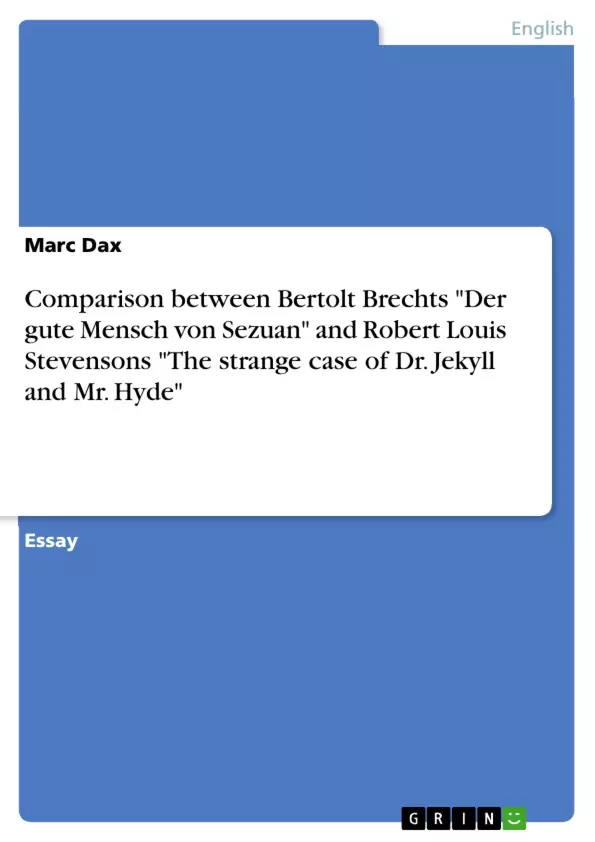Brecht´s stage play is based predominantly on his own real life experiences and that Brecht needed a long time to develop it. On the other hand Stevenson used nothing but a dream to create his work, and he did so in a very short period of time. Brecht´s Der gute Mensch von Sezuantotally has 10 chapters, in addition you can find a prologue, five interludes and an epilogue. The prologue tells the reader about the three Gods on the way to Sezuan and what they expect of the people. In the interludes the happenings of the former chapter become summerized and the next chapter becomes introduced. The epilogue deals with the expression of an actor, he apologizes that there is no really an end inDer gute Mensch von Sezuan.The audience or the reader have to find their own end, inThe strange Case of Dr. Jekyll and Mr. Hydean end is given. In comparison to Stevensons narrative story, BrechtsDer gute Mensch von Sezuanis a stage play. Although the books are written in two different litterary forms, both introductions strike the point of social setting. The bookThe Strange Case of Dr. Jekyll and Mr. Hyde begins with the first chapter “Story of the door” where Mr. Utterson is introduced by the narrator: “Mr Utterson the lawyer was a man of a rugged countenance […] he drank gin when he was alone” (Stevenson 3). In Der gute Mensch von Sezuanthe beginning is similar. In the prologue Wang introduces himself, he tells the reader that he is a water salesclerk and that the buisness is very hard: “Ich bin Wasserverkäufer hier in der Hauptstadt von Sezuan. Mein Geschäft ist mühselig. Wenn es wenig Wasser gibt, muß ich weit danach laufen. [...] Aber in unserer Provinz herrscht überhaupt große Armut“ (Brecht 7). In both books the introduction does not start with the protagonists, furthermore the introductions already show the reader at the begining whether the protagonists are poor or rich, in what kind of societies the protagonists live and what kind of characters Mr. Utterson and Wang are. The quotations point out at the beginning of both books that Wang is a worker, he has to work hard if he wants to earn money. In contrast Mr. Utterson is a more educated man and he does not need to work as hard as Wang does. The reader sees that in The Strange Case of Dr. Jekyll and Mr. Hyde the protagonists, as well as the other characters are more prosperous than in Der gute Mensch von Sezuan. [...]
Inhaltsverzeichnis (Table of Contents)
- Introduction
- Comparison of the Basis of Both Books
- The Introduction of Both Books
- The Characters of Both Books
- The Different Narrative Styles
- The Motive of the Books
- The Two Personalities
- Conclusion
Zielsetzung und Themenschwerpunkte (Objectives and Key Themes)
This essay aims to compare and contrast the works of Robert Louis Stevenson and Bertolt Brecht, focusing on the theme of disguising protagonists and their motives. The essay examines both authors' literary techniques and explores the similarities and differences between their works.
- The role of disguises in shaping character development
- The exploration of dual personalities and their implications
- The contrasting social settings and environments portrayed
- The use of narrative style to enhance the understanding of the characters and plot
- The impact of real-life experiences on the authors' creative process
Zusammenfassung der Kapitel (Chapter Summaries)
- The Introduction: This chapter provides a brief overview of both authors' backgrounds and their common literary interests, focusing on the theme of disguised protagonists.
- Comparison of the Basis of Both Books: This chapter delves into the origins of both novels, exploring the real-life experiences and inspirations that influenced their creation.
- The Introduction of Both Books: This chapter examines the opening chapters of both books, highlighting the social settings, character introductions, and immediate insights into the protagonists' circumstances.
- The Characters of Both Books: This chapter presents the main characters of both works, providing descriptions and outlining their roles in the narrative.
- The Different Narrative Styles: This chapter compares the narrative techniques employed by each author, exploring the impact of dialogue and narration on the reader's understanding of the story.
- The Motive of the Books: This chapter examines the underlying themes and ideas explored in both novels, focusing on the motivations behind the protagonists' actions and their impact on the narratives.
- The Two Personalities: This chapter analyzes the concept of dual personalities and its implications for both protagonists, exploring their struggles with their inner conflicts.
Schlüsselwörter (Keywords)
The essay examines key themes related to disguise, dual personality, social setting, narrative style, and the impact of real-life experiences on literature. It focuses on the works of Robert Louis Stevenson and Bertolt Brecht, highlighting the protagonists Dr. Jekyll/Mr. Hyde and Shen Te/Shui Ta. The essay also explores the contrast between narrative and dramatic literature, and the effects of poverty and societal pressures on the characters' choices.
- Quote paper
- Marc Dax (Author), 2005, Comparison between Bertolt Brechts "Der gute Mensch von Sezuan" and Robert Louis Stevensons "The strange case of Dr. Jekyll and Mr. Hyde", Munich, GRIN Verlag, https://www.grin.com/document/57514



